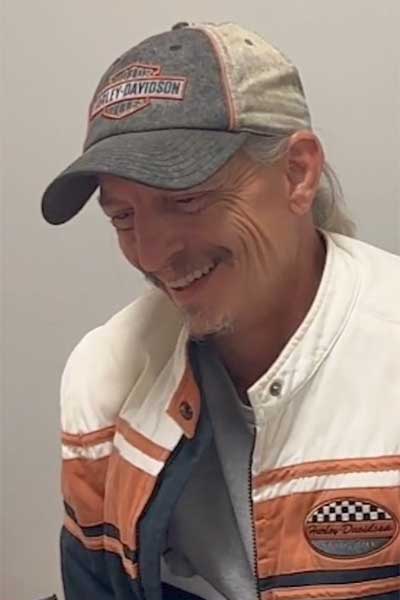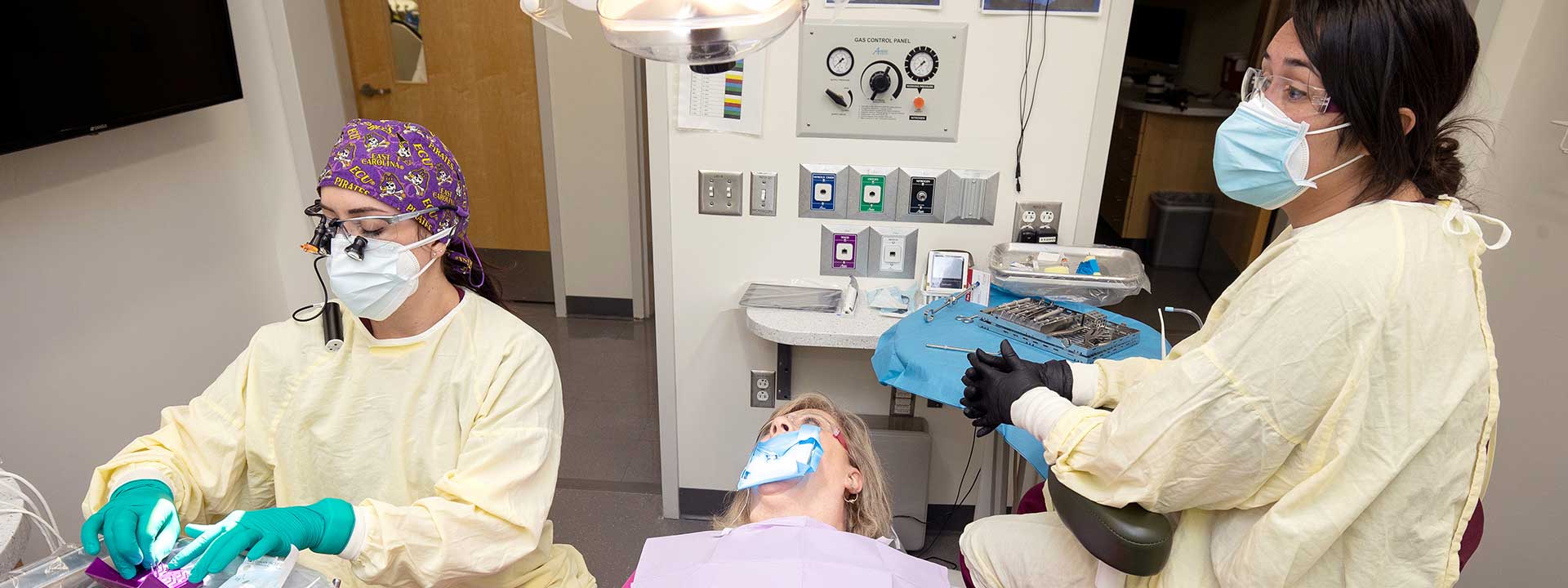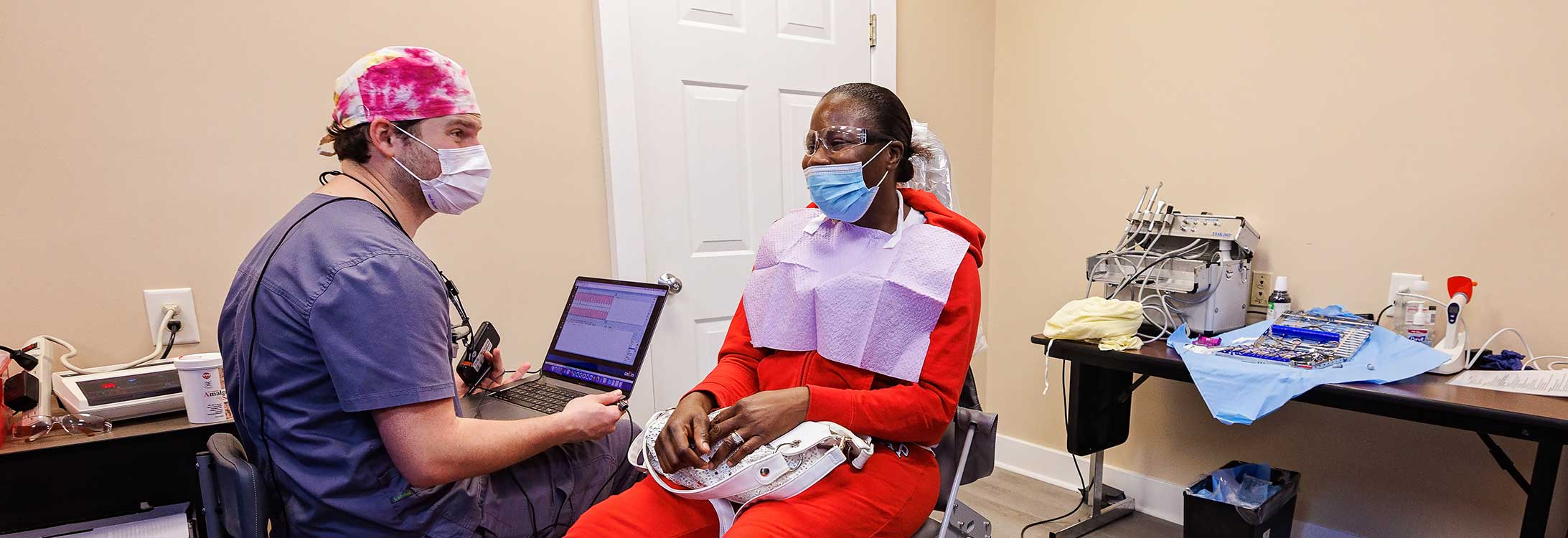100,000 SMILES
ECU dental school marks statewide care milestone with 100,000 patients served
Mike Sheppard was a part-time drummer, keeping the beat to his band’s classic rock tunes during gigs in and around his hometown of Canton, North Carolina.
But that musical rhythm was interrupted by a different kind of tempo — the throbbing pain that he almost constantly felt in his teeth and mouth. That’s when Sheppard had to set down his drumsticks.
He sought help at the East Carolina University School of Dental Medicine’s community service learning center (CSLC) in Sylva, where he received care during the school’s ECU Smiles for Veterans event in December.

Patient Mike Sheppard discusses his oral health care experience at the ECU School of Dental Medicine’s community service learning center in Sylva. (Photo by Jon Jones)
“It’s been life-changing,” Sheppard said.
He and more than 100,000 patients have received care through the School of Dental Medicine’s on-campus and hospital clinics, CSLCs and community program sites across the state — an achievement that goes well beyond a headcount, but is instead measured by smiles restored.
“Celebrating this milestone is not just about a number,” said Dr. Greg Chadwick, dean of the ECU School of Dental Medicine. “It is about educating the next generation of dentists as we provided much needed care to 100,000 North Carolinians, many of whom may not have had access to this care if it were not for our community service learning centers across the state and our supporters and donors who have been there from the beginning.”
The School of Dental Medicine opened its doors to students in 2011, driven by a mission of preparing dentist leaders and increasing access to oral health care for patients across the state, especially in rural and underserved communities. Since 2012, the school’s model has expanded through the creation of the CSLCs and innovative programming that reaches more patients where they are.
“This is a landmark moment for ECU and the School of Dental Medicine,” said ECU Chancellor Philip Rogers. “This is not only a milestone, but also a mile marker, as we are just getting started. It is a reminder that we are upholding a promise we made to the people of our state to prepare new dentist leaders and increase access to oral health care for patients everywhere, including our most rural communities.”
Over the course of his visits to the CSLC-Sylva, Sheppard received partial dentures and repairs to cracked and broken teeth. The difference, he said, has been evident in daily life.
“Before, I was in lots of pain; at least two or three days a week I’d be functioning with really bad pain,” he said. “Now, I feel 100% better than I did.”
Sheppard has also returned to his music.
“Since last year, we’ve done seven gigs that I hadn’t done for years before because of the pain,” he said. “I can do this again and not have to worry about the pain and embarrassment. If affects the way you perform. When you can smile and you couldn’t before, it’s confidence — and confidence can lead to other things.”
‘A mutually beneficial setting’
“When I first heard ECU School of Dental Medicine has treated 100,000 across the state, my first response was, ‘Wow!’ This accomplishment is incredibly impactful to all of North Carolina, and knowing I was a small part in that, is very special,” said Dr. Jennifer Vrikkis ’16, who practices at Reynolda Smiles Family Dentistry in Winston-Salem. “I can’t believe it’s been several years since leaving formal education and starting my journey in private practice, but I still feel like I’m a part of ECU with the same mission to serve our community.”
An important piece of the school’s model is recruiting and educating students who have shown the desire to make a difference for North Carolina through dentistry. These students and alumni come from all over the state, bringing with them a passion for caring for others through creative and daring initiatives.
Close to 90% of ECU School of Dental Medicine graduates practice in North Carolina, a number that could be impacted by the school’s unique model of care. During their fourth year, students gain experience at three of the school’s eight CSLCs across the state, as well as clinics in Ross Hall, the school’s campus facility.
That model not only provides a wider variety of clinical experiences for students, but more opportunities for patients to receive care.
Dr. Robert Pinner ’21 runs Pinner Family Dental in Greenville and considers the latest milestone a win for students and alumni from the school’s first days.
“Though I’m just a small link in a long chain of participants, it gives me tremendous satisfaction to see all we have collectively accomplished,” Pinner said. “This mutually beneficial treatment and learning setting—and the doubly positive outcomes it provides—is really the overlooked ‘secret sauce’ that sets our students apart. Upon graduating, our students are ready and prepared to go practice dentistry at a high level. Building this model was intentional and took a great deal of forethought and diligence.”
Dr. Roopwant Kaur, assistant dean for engagement and clinical associate professor of operative dentistry, said the milestone is a testament to the school’s commitment to delivering care based on a proactive and assertive approach, “demonstrating commitment to pioneering and innovative strategies in addressing complex health care challenges.
“This remarkable accomplishment serves as a shining example of our unparalleled success in balancing our core educational mission, impactful community service initiatives and unwavering dedication to clinical excellence,” she said.
Dr. Jasper Lewis Jr., a Greenville pediatric dentist who supported and guided the dental school’s creation, said the school is going beyond the mission and vision it was first founded to achieve.
“Our students are exposed to the same curriculum as other schools, but in a model that gives them a broader exposure to dental needs of all types of patients from a large variety of educational and financial backgrounds across the state,” said Lewis, also the namesake of the school’s first endowed professorship. “Students are taught not only the didactics and mechanics of dentistry, but how to be efficient for the patients as well as themselves. This helps them to see more patients in a given time at less expense to both the patient as well as the provider.”
The mountains-to-coast approach
Esse quam videri.
The state motto of North Carolina is a poignant yet bold call “to be, rather than to seem.” ‘To seem’ is stationary. ‘To be’ is a journey, a calling.
The School of Dental Medicine’s mission has long been less about words and more about works — finding ways to tangibly reach more patients while preparing dentist leaders eager to care for a state that needs them. The school is built on a combination of hope, grit and determination that intersect at a crossroads of better health and better lives.
“Over the years, our students have not only learned to care for the patients they interact with, but they have also nurtured their inherent desire to serve,” said Dr. Margaret Wilson, vice dean and interim associate dean for student affairs. “Our students and alumni are living and working our mission, and their hard work shines through this meaningful milestone. Each of them has left a mark on our school, and in turn, on the patients they care for and in the communities where they make a difference.”
The CSLC system, an award-winning model that includes centers in Ahoskie, Brunswick County, Davidson County, Elizabeth City, Lillington, Robeson County, Spruce Pine and Sylva, each sprung from roots carefully cultivated in their communities spanning regions, demographics and distinctive needs. These centers serve as the school’s “secret weapon” against the challenges North Carolina faces in oral health care — aging dentists, remote locations, lack of insurance or means of funding care and other challenges specific to communities, families and patients.
“Seeing the plan unfold from the perspective of the community service learning center has been an enriching experience,” said Dr. Ford Grant, faculty director of the CSLC-Ahoskie. “From my pre-ECU perspective, it is remarkable that 100,000 patients have been cared for since the first patient was seen in Ahoskie in July 2012. How would these patients have received care without the school? It is a humbling thought as we celebrate this milestone.”
Grant said the number also signifies that there is a long way to go still.
“So many more of our North Carolina citizens still have access to care issues,” he said. “The main campus at Ross Hall and the rural-based community service learning centers can only meet some of the unmet dental needs of the state. ECU’s model is in a great position to support dentists in rural locations through continuing education and community service projects. Being involved in underserved areas can help lift up communities by providing much-needed dental care and has encouraged young people in rural areas to seek careers in the health professions. We hope our staff, students and faculty interacting within the community continue to help inspire others.”
Caring for special populations
When Bruce Hair started having dental issues, he stopped talking. He didn’t want to meet new people or be put in a position to hear jokes or ridicule.
Hair, of Franklin, North Carolina, had dealt with a broken front tooth for more than a year when he sought help at the CSLC-Sylva through ECU Smiles for Veterans.
“I am so happy with the outcome,” Hair said. “When I was missing that whole front tooth, I was uncomfortable around strangers and anywhere for that matter. I just let it get to me in a personal sense. I had stopped smiling; my life was just kind of closing in.”
These days, he can be himself again.
“Now that I can smile and look at people and talk in a normal way, I’m just a lot happier,” Hair said.
Hair and other patients who are considered part of special populations — veterans, children, the elderly, those with special care needs — have found more accessible oral health care thanks to the school’s programs focused especially on them.
In addition to ECU Smiles for Veterans, the school offers the Sonríe Clinic for migrant farmworkers, school-based dental programs in Bertie and Jones counties and a monthly clinic in Hyde County, among other volunteer and outreach programs. Since 2020, the school-based programs alone have provided more than 12,000 preventive and diagnostic services to over 1,000 children in Bertie and Jones counties who have extremely limited access to care, said Rachel Stewart, supervisor of school-based oral health prevention programs for the School of Dental Medicine.
“Being on the front lines of these programs is an amazing opportunity to connect with patients and community members,” Stewart said. “By staying immersed in the community, we can see the changes as they happen and connect with community members and leaders to learn how to best serve the children of the county. Not only do the programs provide clinical services, but we also provide oral health education and supplies to each child.”
Third-year dental students develop age-appropriate presentations that they present in each county as well, improving the oral health literacy of the children while also helping the dental students develop their passion for working in underserved communities.
Faculty and student research also leads to reaching more patients and finding more innovative ways to care for them; the school’s research base is expanding and taking advantage of resources, grants and partnerships across the state and nation. Special needs care capabilities are also expanding through state allocations and other funding.
The growth in these areas keeps some students confident that their ECU School of Dental Medicine experience is preparing them to care for the next 100,000 patients.
“Being a part of the school has been an inspiring journey,” said fourth-year dental student Cherina Jo McKnight. “I knew that committing to this school would teach me the keys to unlock many doors closed to underserved populations. I believe that one of the most rewarding aspects of becoming a dentist is making a difference in someone’s life while doing something I truly love.”
Chadwick said the momentum is building for the school’s most fruitful years to come.
“Each of these 100,000 patients is a North Carolinian, a part of our dental school community and a face that represents our mission and vision,” he said. “We are grateful to them for entrusting their care to us — and we look forward to restoring and creating even more smiles across the state as we enter the next chapter in the life of our school.”

Patient Barbara Hardy prepares for a procedure to be completed by now-alumna Victoria Hardy. (Photo by Rhett Butler)
